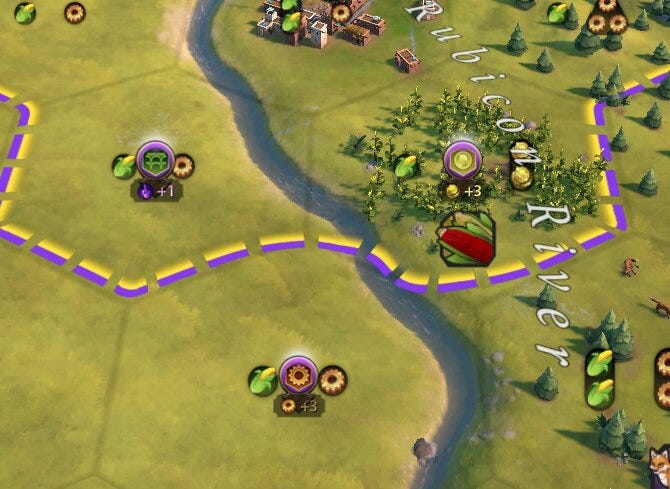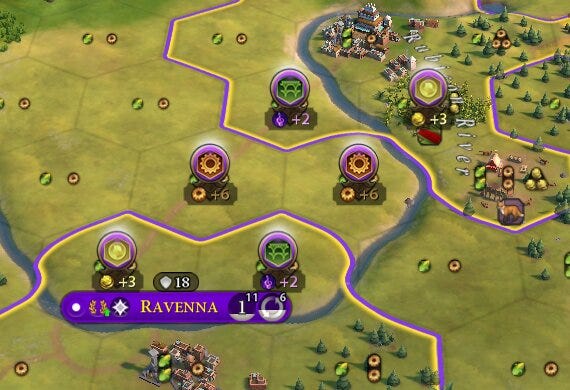On Towards the Stars: Planning a City Layout
Civ 6 introduces 'unpacked' cities with adjacency bonuses. Here's how to make the most of them.
[This post is part of a larger strategy guide for Civilization 6]
Whenever you think about settling a new city, you should take a turn to plan how it will be built. A bit of planning can help you rack up adjacency bonuses, which make a huge difference in your game play.
Many districts will get adjacency bonuses from geographic features — for example, campuses get +1 for each mountain, +2 for each reef and geothermal vent. It's obviously worth identifying places where you can get these easy bonuses and marking them on your map for later. But in this section, I want to focus more on adjacencies you can control. Geography is in some sense random; sometimes you'll get lucky, other times you won't. But if you can consistently get adjacencies regardless of your start position, you'll be much better off.
Again, I have to stress the importance of using the Map Tacks mod. Map Tacks show you how many adjacency bonuses you will get from placing districts, and will warn you if you cannot place a district for any reason. They are also useful for your own memory, allowing you to reserve spaces for farms, infra, or wonders that you know you need later.
Industrial zone triangles
You should basically always start by thinking about your production, which generally means industrial zones and commercial hubs. Industrial zones get +2 bonuses from being near aqueducts, dams, and canals. Both aqueducts and dams need to be on water. And commercial hubs get a +2 bonus for being near rivers.
Hopefully the pattern is obvious: you can place your Industrial zones, commercial hubs, and at least an aqueduct next to each other, getting +3 coin and +3 production.

These bonuses extend to multiple cities — if you put two Industrial Zones next to the same aqueduct, they both get the bonus. And if you put two aqueducts next to the same Industrial Zone, the Industrial Zone will get a +4 bonus.
So, if you "point" your Industrial Zone towards another city along a river, you can double the triangle pattern and double all of your production adjacencies.
And of course, if you have a river system with a fork, you can pull off a rare triple Industrial Zone triangle.
Once you have your main Industrial Zones, Commercial Hubs, and aqueducts/dams planned, you can layer on a few other districts to try and squeeze out a bit more juice on your bonuses. A government plaza is a great choice — it gives an additional +1 bonus to everything around it and is generally cheap to build.
Check out those bonuses! Consistently getting +6 to +10 on your production buildings is huge. And with the Craftsmen policy card, you can double those bonuses.
Note: one of the things I enjoy about civ is the level of thought that went into making the historically consistent thing also the game optimal thing. Cities around the world had industrial heartlands along their primary rivers; civ is the same, encouraging a concentration of industry and commerce in one heartland between your cities.
Theater adjacencies
Theater squares are tricky. They get adjacencies primarily from wonders and entertainment complexes — wonders are hard to build, and entertainment complexes are rarely worth building. In my opinion, theater square adjacencies are the hardest to land in any game, so it's worth calling out how to generate them.
First, I highly recommend placing theater squares next to your big industrial heartland. Theater squares, like all districts, get an adjacency for every 2 bordering districts including your city center. Because there are so many other districts along that main river, you can generally guarantee at least one culture bonus. With a careful eye to your city placement and Government Plaza, you can sometimes get up to +3 just from your other districts.
Second, over the course of a game, you're likely to build at least one wonder. If you can place that wonder in a central location, you can surround it with theater squares. You should try to figure out well in advance which wonders you want to build and where you can place them. For example, if you know you want to build Mahabodhi Temple, you have to have a forest next to a Holy Site — that's a pretty constrained subset of tiles, and will limit where you can place Theater Squares for adjacencies. Although it's difficult to guarantee winning a wonder, planning in advance (and placing tacks down) can give you a big leg up in determining what wonders are even viable for your overall city layout.
Note that a lot of wonders ALSO depend on being on a river, including Hanging Gardens, Etemenanki, Big Ben, and more. If you know you can win many of these wonders, you can aim to get multiple wonder adjacencies on the same theater square.
Builder improvements
In some ways, it's obviously important to plan districts because you really only have one chance to get it right — once the district is placed, it can't be moved.
But I think it's often equally important to plan for builder improvements. A lot of builder improvements have adjacencies of their own. They often require very specific tile conditions. They can be critical determinants in how well a city grows. And, practically, a city with 20 pop is only going to have ~5-8 districts. A city can have max 36 tiles. The rest of those have to be filled with something else!
At minimum, you should look for triangle farms — three farms in a triangle that all get +1 food after unlocking feudalism. If you have options, it's a great idea to keep your farms away from the rest of your districts so that you do not accidentally ruin a triangle farm by using a tile for something else. Placing tacks is, again, your friend — do it early and often.

Your civ or vassal city states may have unique builder improvements, many of which cannot be placed next to one another. These improvements can be really powerful, and it's worth determining how many of them you want in a city to make room for them early. One Monastery may only give +2 faith and +1 housing. But FIVE monasteries is a highly populated, game changing city.
Overall, planning a city is a bit of an art form. Take the time to do it (with tacks) every time you settle. You'll very quickly figure out what works and what doesn't.






